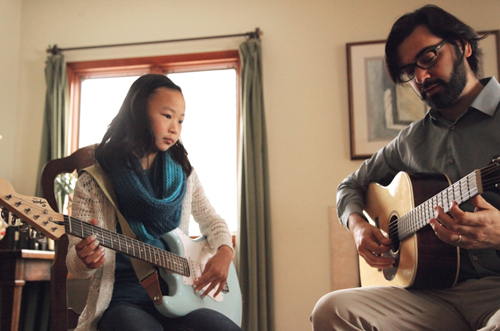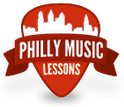
Moveable Chord Forms on the Guitar
In this article, I’m going to discuss some basic chord shapes on the guitar in open position and show you how to turn them into movable chord forms. It is recommended that you have a basic understanding of open chords and are able to switch between them fluidly before trying the methods discussed below.
What is a moveable chord form anyway?
A movable chord form is a chord played with no open strings, that can be moved up and down the neck. You will maintain the basic shape of the chord no matter where you play it. However, the letter name of the chord will change as you move (the terms chord “form” and chord “shape will be used interchangeably throughout this article). It is important to know the root note of the chord so you can determine what chord you’re actually playing as you move the form. Knowing the notes on the guitar will help you.
The most popular moveable chord forms are often referred to as “barre chords” on the guitar, because they require you to create a “barre” across all six strings with the 1st finger on your fretting hand. Your first finger is essentially acting as a capo, so that you can move chord shapes up and down the neck freely. If you’re not used to barring with your 1st finger, this can be difficult in the beginning, but stick with it, and soon your barre chords will sound just as good as if you were playing with a capo! Here are some technique exercises that will help you stretch and strengthen your fingers to make playing barre chords easier. You can also read my article on fretting hand technique to supplement the exercises.
What Chord Forms Can I Move Around the Neck?
Well, the real answer is all of them! However, we’re going to start with some of the basic major chord shapes, because they are the theoretical foundation for every other chord. The five shapes that we’ll discuss in this article are often referred to as the CAGED chords, named after the chords that these shapes make in the open position.
The most popular movable chord shape is the E shape, so we’ll start there for the purposes of this article.
Let’s Start Moving Some Chords Around!
Here is the basic E major chord shape in the open position, the one that we all know and love with the standard fingering:
The key to turning an open chord form into a movable chord form is to first learn how to play the chord in the open position without using your 1st finger. We have to free up your 1st finger in order to create the barre that will enable you to move the chord shape up and down the neck.
Here is the same E major chord with a different fingering which frees up your 1st finger:
Now that your first finger is freed up, you’re ready to turn this shape into a movable chord form! Barre your first finger behind the nut of the guitar by laying your entire 1st finger across all six strings. This will give you a sense of how this chord shape will feel to play once you move it. Now slide everything up one fret and you get an F chord shown below:
It is important to know that the lowest root of this shape is located on the low E string. So when you’re in the open position it creates an E major chord (the letter name of the chord is always named after the root note). Because E and F are on half step away from each other, when you move the shape up a half step, the same chord form becomes an F major chord. If this is confusing to you, please read this article on the musical alphabet and how it can be applied to guitar.
Continuing Up the Neck
Let’s move this same shape up the neck one more time. The F major chord is in first position with it’s root on the F note located on the first fret of the low E string. If you move up a whole step to the third position, then the root changes to a G, making the new chord a G major.
This can be continued all the way up the neck, until the notes start to repeat at the 12th fret. In this way, you can play all 12 major chords with the same chord form! Knowing how to play movable chord forms on the guitar will open up a whole new world of possibilities playing all over the neck, instead of just staying in the open position. Knowing how and when to use these chord forms will also help you begin to understand the fretboard and it will serve as the foundation to learning your pentatonic scales and basic music theory on the guitar.
In the next article, we’ll talk about how to do this with the other four major forms in the CAGED system.
Joseph Primavera
I teach Guitar, Bass, Piano and Ukulele. I am a music educator, performer, composer and producer with over 15 years of experience. Since obtaining my Bachelor’s of Music in Performance from Temple University in 2007, I have been teaching private music lessons in the greater Philadelphia area to students of all ages and skill levels. My teaching style focuses equally on technique, theory and improvisation. I like to tailor the lessons to each individual student's goals and interests, all while focusing on the music that they find interesting and inspiring. In 2002, I was one of only two guitar players in Pennsylvania chosen for the Pennsylvania Governor’s School for the Arts. In 2010, I recorded the music for a full length documentary called “Libertopia". In 2011, I co-lead the launch of a recording program at The Hill School in Pottstown, PA. Since graduating with my degree in jazz performance, I have been featured as a guitarist performing in a variety of genres, and have contributed guitar to multiple recordings, including works recorded at Miner Street Recordings in Fishtown. In addition to guitar and music in general, I have been teaching audio engineering, production and mixing. I have also had a key role in the production and engineering for the albums of many local bands, including Juston Stens (former drummer for Dr. Dog), TJ Kong and the Atomic Bomb, Grubby Little Hands, and The Looks of It (my personal project). In 2009 I founded Philly Music Lessons to bring a unique form of music education to my own neighborhood and to Philadelphia at large. Whether you are just starting out and want to learn some of your favorite songs or preparing for a college audition, I have the tools and experience to help you achieve your musical aspirations. Schedule a Lesson




